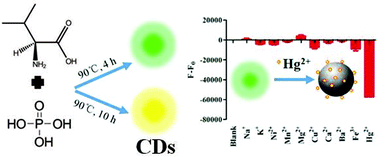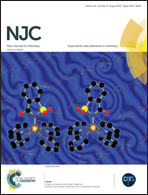Valine-derived carbon dots with colour-tunable fluorescence for the detection of Hg2+ with high sensitivity and selectivity
Abstract
Hg2+ is one of the most ubiquitous pollutants in the environment and is a danger to human health. There is a need for a simple highly sensitive method of for the detection of aqueous Hg2+. Carbon dots (CDs) have attracted widespread attention due to their potential application in bioimaging, chemisensors and photocatalyst design. We have now developed a simple and efficient method for the preparation of P-doped carbon dots (CDs) with tunable fluorescence, using L-valine as the carbon source and H3PO4 (85%) as oxidant. The fluorescence of CDs can be tuned from green (CDs-1) to yellow (CDs-2) by simply controlling the reaction time at a relatively mild temperature (90 °C). The CDs obtained exhibit bright photoluminescence with quantum yield (QY) up to 44.8% for CDs-1 and 31% for CDs-2, together with excellent biocompatibility and water solubility. pH and NaCl solution had no significant effect on the fluorescence intensity of CDs-1. More importantly, the green CDs show high sensitivity and selectivity in the detection of Hg2+. Two different fluorescence quenching modes have been established, the lower limit of detection (LOD) being about 1.51 nM.


 Please wait while we load your content...
Please wait while we load your content...